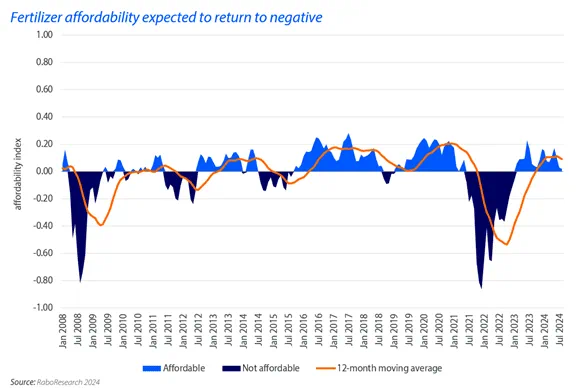In 2024, the global demand for fertilizers is showing a
sluggish trend.
According to the new report of RaboResearch, in 2024, the
demand for fertilizers did not maintain the growth trend of 2023. Instead, it
remains in a sluggish state.
Not only that, as farmers' operating profit margins are
facing pressure, the report predicts that the fertilizer affordability index
will turn negative from a balanced state in the second half of this year.
However, Bruno Fonseca, a senior analyst of agricultural
inputs, analyzed that due to the increase in fertilizer prices and the pressure
on farmers' operating profit margins caused by the sluggish prices of
agricultural commodities, it is expected that the growth in fertilizer demand
will not return to the level of 2023 within the next six months.
In addition, Fonseca also said that the prediction of strong
global crop production continues to put pressure on the commodity market, thus
leading to a drop in market prices and further reducing farmers' operating
profits.
The prices of nitrogen fertilizers and
phosphate fertilizers being higher than the historical average is also an
important reason for the reduction in farmers' profits.
Under the combined effect of these factors, farmers' ability
to purchase fertilizers will become low.

Phosphate fertilizer
In recent months, the market's affordability for phosphate
has significantly deteriorated due to the increase in fertilizer prices of
monoammonium phosphate and diammonium phosphate as well as unfavorable
commodity prices.
The reduction in global phosphorus market supply may push the
price of phosphate fertilizers above the historical average. This is precisely
because the strategies of the three major exporting countries have changed.
In China, from 2018 to 2021, about 9
million tons of monoammonium phosphate/diammonium phosphate were exported
annually. From 2022 to 2023, the average export volume decreased to 6.3 million
tons.
By April 2024, China's phosphate fertilizer production had
returned to the previous level, but the price did not fall either.
And the United States has changed its phosphate market
strategy. While reducing the import and export of monoammonium
phosphate/diammonium phosphate, it has increased the import of phosphate rock.
From 2021 to 2023, the United States exported about 1.26
million tons of monoammonium phosphate/diammonium phosphate, which accounted
for only 20% of the export volume from 2018 to 2020. Therefore, it can be
expected that the export volume will continue to decrease in 2024.
Morocco has also changed its strategy. Since 2018, Morocco
has significantly reduced the export of phosphate rock and at the same time
increased the export of monoammonium phosphate and diammonium phosphate. The
export volume of phosphate rock has decreased from 11.2 million tons in 2018 to
4.5 million tons in 2023.
Nitrogen fertilizer
Under the condition that urea prices fluctuated
due to supply issues at the end of June, the affordability index of nitrogen
fertilizer still remained stable.
Here are several uncertainties caused by
factors.
First is in Europe.
Urea prices have been on a downward trend.
However, it was not until the news of Egypt stopping production due to natural
gas supply issues in mid-June 2024 that, in turn, pushed urea prices to rise by
17% in just one month.
In addition, natural gas prices in Europe have
risen this summer, from 31.4 euros/MWh in mid-July to 39.6 euros/MWh on August
15.
Due to concerns about price fluctuations,
European buyers are hesitant when purchasing urea, directly leading to weak
demand in this region.
Then there is Brazil.
In Brazil, farmers are focusing on purchasing
fertilizers such as urea for planting safrinha corn crops. However, fertilizer
prices are rising, making fertilizer demand in this region difficult to
predict. But import data from July shows that from January to July this year, Brazil
imported 3.6 million tons of urea, which is 3% higher than the average level of
the past five years.
Finally, there is India.
As the largest provider of liquidity in most
fertilizer markets including nitrogen fertilizer, there is news that its inland
inventory may be higher than normal levels. This may also lead to a reduction
in India's demand for new tenders or even a delay in tenders.
Potassium fertilizer
The affordability index of potassium fertilizer
improved slightly in July. The decline in fertilizer prices offset the negative
impact of the deterioration in commodity prices.
In Rabobank's report, the optimistic outlook for
potassium fertilizer is affected by the recent procurement contracts of China
and India as well as the saturated demand in Brazil.
It is reported that China and India are
negotiating to reduce the procurement price by 12% compared to the currently
paid price, but this is a disadvantageous factor for potassium fertilizer
prices in other regions.
And Brazil has negotiated for new production
below $300 per ton. Brazilian importers who have obtained large discounts have
purchased a large amount of potassium fertilizer this year. According to data
from January to June 2024, the amount of potassium fertilizer imported by Brazil
reached 6.9 million tons, which is 1.6 million tons more than the average
import volume in the past five years.
In general, the price of potassium fertilizer
has decreased, but it is not entirely good news.
The report predicts that the price of potassium fertilizer
may become very low in the future and may even approach the operating costs of
fertilizer companies. This may ultimately lead some companies to reduce
production to avoid losses.
RaboResearch has also made a prediction that fertilizer
demand will experience a small amount of growth in the next two years.
Phosphate fertilizer demand will continue to be
under pressure in 2025. Although there is a growth trend in 2026, the growth
rate is not significant.
Nitrogen fertilizer demand will continue to
recover in 2025, but at a relatively slow pace. It will experience a slight
rebound in 2026.
The demand for potassium fertilizer has already
rebounded moderately in 2024. The growth rate will slow down in 2025 and will
increase again in 2026.